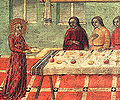Top Qs
Timeline
Chat
Perspective
May 31 (Eastern Orthodox liturgics)
From Wikipedia, the free encyclopedia
Remove ads
May 30 - Eastern Orthodox Church calendar - June 1

All fixed commemorations below celebrated on June 13 by Orthodox Churches on the Old Calendar.[note 1]
For May 31, Orthodox Churches on the Old Calendar commemorate the Saints listed on May 18.
Saints
- Apostle Hermes of Philippopolis (Hermas), of the Seventy Apostles (1st century)[1][2]
- Martyr Hermias of Comana (160)[1][3][4][note 2]
- Martyr Magus (the Magician), who converted upon witnessing the martyrdom of Hermias (160)[1][5][note 3]
- Martyr Philosophus at Alexandria (252)[1][6]
- Martyrs Eusebios and Charalampos, in Nicomedia, by fire.[7] (see also May 30)
- Five Martyrs of Ashkelon, dragged to death.[8]
- Saint Eustathius, Patriarch of Constantinople (1025)[1][9][note 4]
Remove ads
Pre-Schism Western saints
- Virgin-martyr Petronilla, at Rome (1st or 3rd century)[4][10][11][note 5]
- Martyr Crescentian, in Sassari in Sardinia (c. 130)[4][11][12]
- Martyrs Cantius, Cantian, Cantianilla and Protus, in Aquileia (304)[4][11][13][note 6]
- Saint Sylvius of Toulouse, Bishop of Lyon (c. 400)[14]
- Saint Lupicinus of Verona, Bishop of Verona, described as 'the most holy, the best of bishops' (5th century)[4][11][15]
- Saint Paschasius, Deacon and Confessor in Rome, who is mentioned by Pope Gregory I (512)[4][11][16]
- Saint Winnow, Mancus and Myrbad, Irish saints who lived in Cornwall where churches are dedicated to them (6th century)[11]
Remove ads
Post-Schism Orthodox saints
- Saint Philotheus (Leschynsky) of Tobolsk, Metropolitan of Tobolsk and the "Apostle of Siberia" (1727)[1][17][18][note 7]
New martyrs and confessors
- Hieromartyr Archpriest Philosophus (Ornatsky), with his sons Boris and Nicholas, in St. Petersburg (1918)[1][19][20]
- Hieromartyrs Hierotheus (Afonin), Bishop of Nikolsk (1928), and Hieroschemamonk Seraphim (Nikolsky) (1923)[1][21]
Other commemorations
- First translation of the relics (1591) of Hieromartyr Philip II, Metropolitan of Moscow and all Russia (1569), to Solovki.[1]
- Repose of Archimandrite Macarius of Peshnosha Monastery, disciple of Blessed Theodore of Sanaxar (1811)[1]
- Finding of the relics (1960) of New Martyr Nicholas the Deacon, of Mytilene (1463)[1]
Icon gallery
- St. Hermes of Philippopolis, of the Seventy Apostles.
- St. Petronilla (Aurelia Petronilla), virgin martyr.
- St. Petronilla (Aurelia Petronilla), by Sano di Pietro.
- Saint Philotheus (Leshchinsky) of Tobolsk, Metropolitan of Tobolsk and the "Apostle of Siberia" .
- Hieromartyr Archpriest Philosophus (Ornatsky) (†1918).
Notes
- The notation Old Style or (OS) is sometimes used to indicate a date in the Julian Calendar (which is used by churches on the "Old Calendar").
The notation New Style or (NS), indicates a date in the Revised Julian calendar (which is used by churches on the "New Calendar"). - We do not know what his name was.
- His name is absent in the Synaxaristes and the Menaia, but it is recorded in the Byzantine Calendar.
- "At Rome, St. Petronilla, virgin, disciple of the blessed apostle Peter. She refused to marry Flaccus, a nobleman, and was granted three days for deliberation. She spent these days in fasting and in prayer, and on the third day, after having received the Sacrament of the Body of Christ, she yielded up her soul.[4]
- "At Aquileia, the holy martyrs Cantius, Cantian, and Cantianilla, members of one family, which belonged to the illustrious line of the Anicii. For their attachment to the Christian faith, they were condemned to capital punishment with their tutor, Protus, in the time of Emperors Diocletian and Maximian."[4]
- On June 18th, 1700, Tsar Peter the Great published an Ukase (imperial edict) that made a resounding appeal for the propagation of the Orthodox faith in Siberia and China. In response to the Ukase of 1700, Philothei (Leschinsky) of Kiev was chosen as the Metropolitan of Tobolsk and All Siberia (1702-1711), long since a center of missionary operations, in order to "lead the natives in China and Siberia to the service of the true and living God." He built 37 churches and personally accounted for the baptism of 40,000 Siberian tribesmen by 1721.
Remove ads
References
Sources
Wikiwand - on
Seamless Wikipedia browsing. On steroids.
Remove ads






